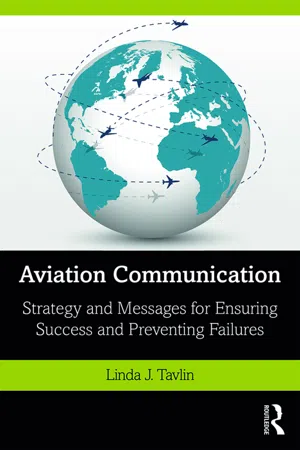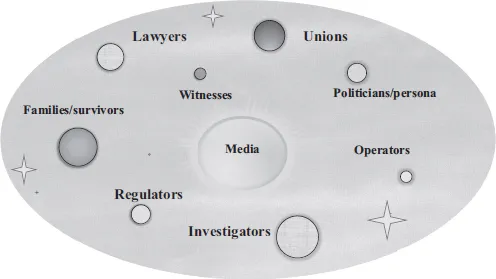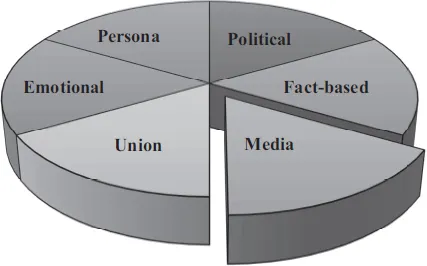![]()
1 Introduction to aviation communication – it’s more than you think!
According to the Air Transportation Action Group (ATAG), there are 9.9 million people directly employed worldwide in the aviation industry. All of them need to communicate with one audience or another daily while doing their jobs, whether they are on the technical, commercial, or regulatory side of the industry. The problem with the subject of communication is that it is intangible and subjective, so if there are 50 people with whom you are speaking, there are likely to be 50 different definitions or interpretations of what your communication means. It cannot be controlled by one organization or department. That is just the way it is, whether the corporate powers that be like it or not.
Communication is defined throughout this book as the ability to convey a fact, policy, or thought to any audience, and in the aviation industry that is a lot of people. For the purpose of this discussion, communication is what any employee or affiliated employee may be faced with in their position or work with an organization dealing with the aviation industry, whether it be a regulator, operator, manufacturer, defense contracting professional, investigator, union, media outlet, customer, passenger, employee and beyond. It applies to anyone in any department who may have to communicate with an audience because of the nature of the work they do or in response to a situation that occurs and could include but is not limited to: accidents/incidents; workplace events; regulatory events; affiliate issues; customer issues; personnel events; environmental events; etc.
If I must cite one example that proves the fundamental nature of communication, it would be the events surrounding the tragic disappearance of Malaysia Airlines Flight MH370 in March 2014. To date, no actual plane has been found. There is no known nor confirmed crash (except for several aircraft parts), no regulatory actions, or anything else. Yet here is a company and a country that were discredited in the eyes of the world.1 What did they do that was so wrong? It was their communication that proved to be fundamental. Communication is not the icing on the cake. It is the cake.
Three points to communication
Have a message
Mistake #1 – Having a strategy that says, “How do we know what our message is until something happens?”
This is not true. There are messages about the job a person does that can be carried around at all times. There are messages about an organization that can be carried around at all times as well, and there are general messages about the aviation industry that can be carried around at all times.
Examples of a message about the job you do would be:
- My job is to take this aircraft from point A to point B.
- My job is to see that the monthly payroll is carried out on time.
- My job is to ensure that our customers receive the service to which they are entitled.
Examples of a message about my/“our organization” would be:
- “Our organization’s” job is to ensure compliance with the Federal Aviation Regulations.
- “Our organization’s” job is to safely facilitate 5,000 daily operations through this airport.
When an employee from any department in the aviation industry is asked, “What is the safest aircraft,” is that an aviation question or a question specific to an organization? The response would be the same no matter what country, organization, or person is responding, thus making it an aviation question. It does not matter what the situation is. The answer to that question should be known based on any scenario in which it may be asked. There is no reason why anyone in aviation should not know the answer to that question.
Another example of a general aviation message that is applicable to all of the industry would be: “Before any aircraft takes off it must be certified airworthy.”
Countermeasure to mistake #1 – An understanding of aviation messages should be learned as a tool during initial aviation training for new employees. After all, aviation is your business. No tickets can be sold without an air operator’s certificate.
Practice your message
Mistake #2 – Practicing for all situations with the same strategy using a briefing book with questions and answers is acceptable.
Your message is your ammunition but all the ammunition in the world will not help you if you cannot aim and shoot. Everyone has a different level of communication skill strength, so it is a good idea to practice the delivery of your message. Some people are good at dealing with technical audiences but terrible with emotional audiences and some people are better at dealing with political or regulatory audiences.
One of the many comments I receive is that people in various workforces think that because they deal at high levels on a daily basis, they do not need to practice their messages, skills, or anything else. This is due to arrogance and the often false assumption that others are as familiar or well versed in operational facets as those who work within the structure every day. The world has seen the results of unpracticed messages too often.
Countermeasure to mistake #2 – Do not practice for all situations with the same strategy. Determine if you are going to educate, clear up a misunderstanding, or fit into a situation whose theme has already been determined.
It’s a thought process
Mistake #3 – Preparing for all situations with the same strategy.
Communication is a thought process. If a question is asked, the answer may be one of several options. For example, one may be asked, “How are you going to apologize for this terrible mistake?” One response could be, “I’m sorry. I’ll never do it again.” Another response could be, “We have nothing to apologize for.” A third response could be, “We are always sorry when a tragedy like this occurs.” One audience could be your director/CEO/commander. Another audience could be a union. A third audience could be family members/ emotional audiences. Each one of those responses might be apapropriate with one of those audiences but you certainly would not go to a family member and say, “We have nothing to apologize for.” You need to think on your feet and develop your response strategy. Communication with regulators needs a different strategy altogether, and far more factual understanding than communication with customers. In all cases, communication must be forthright and factual.
Countermeasure to mistake #3 – The lead for these strategies should be the safety/operations departments to ensure they do not conflict with their ability to deal effectively with their target audience.
Figure 1.1 shows an archaic perception of communication. It implies that the media is the center of everything and all the other potential parties to an event should defer to the media. Clients many times say to me, “If we don’t do this, the media will crucify us, or worse.” This philosophy leads them to develop a reactionary strategy and will lead to failure.
This may have been the way things were before the introduction of the 24-hour news cycle back in 1980, but that 24-hour reporting life inspired competition between news services. Then, with the introduction of cell phones, everyone could be a photo journalist, and anyone might end up on the evening news or on a news blog through no fault (or with no control) of their own. That was followed by the advent and proliferation of social media. Now events are photographed, recorded, and published digitally almost as they happen. Media itself is no longer at levels of old: in today’s environment, more people get their news digitally than from print or by watching television newscasts.
To say that this is just a new phenomenon since the onset of social media is a fallacy. Within one hour of Swissair Flight 111 crashing, I heard someone on CNN comparing it to the ValuJet crash of 1996 because there had been smoke reported in the cockpit. The Swissair tragedy took place on September 2, 1998, before the onset of social media. Granted, the time element was much quicker but the concept is the same – information coming out, whether right or wrong, in the immediate aftermath of an event. And the immediate perceptions are often lasting facts.
Figure 1.1 Media misperception
Figure 1.1 focuses on the media as though they are the epicenter of everything. It portrays them as though they are the sun and all the other potential parties to an event are planets orbiting the sun. If an organization has a strategy which incorporates the above older philosophy, then it is a strategy that gives social and traditional media the power to control how the event is reported and perceived. It means you will not be proactively in control of your message and you will be left with a strategy that limits you to reactively answer questions. If that happens, no matter who the audience is, you will be in a position where the party asking the questions is able to control where they take the discussion because you will merely be following and reacting. The reality is reflected in Chart 1.1.
Chart 1.1 shows the potential parties to an event. Each of these potential parties has their own style of communicating. Failing to take into consideration their styles of communicating when developing a communication strategy will leave you with a strategy that does not meet today’s communications reality.
Let’s examine one by one the various styles of communicating and what each brings to an event.
Chart 1.1 Potential parties to an event
Potential parties to an event
Fact-based communication
The fact-based style of communicating is what all people in the aviation industry should practice, unless they are representing a union perspective. The good thing about the aviation industry is its interlocking system of checks, balances, and oversight. Nothing that is done in the aviation industry is arbitrary. There is data, proof of what has happened or what an organization has done, examples of audits, safety, and proactivity.
When you represent the fact-based perspective, you are there because you represent “our organization” and the process. If you make the mistake of representing yourself, giving your opinion or something similar, you lose the ability to represent the fact-based perspective.
Political-style communication
The next style of communicating is the political style. This does not necessarily refer to an elected official. It is a style of communicating for someone who comes forward, states what they want (generally self-serving), and a year later when a report comes out, or a lawsuit is completed, the statement may or may not be proven to be true or factual – and a fact-based party to the event must then counteract the political statement. An example of political-style communication is someone who appears on television within an hour of something happening as the proclaimed industry expert without having any hands-on working relationship with the event at hand, nor verified factual knowledge of the situation. Another example that fits into this category would be the “witnesses have said” or “sources have told us.”
Persona communication
A persona is an individual with stature or star power. People seek him/her out for attention or he/she may seek out attention. He/she attracts attention to an event as well as to themselves. You never know if you will have a persona as a party to an event. An example of this would be a corporate CEO with star power such as a Sir Richard Branson. If something happened with Virgin Atlantic, people would expect to hear from him. If it were another airline, the world would not necessarily be familiar with who was the head of the organization. In addition, you never know who might be on an aircraft.
Emotional-style communication
The emotional audience is anyone (individual or collective) who identifies with something that happened. They want two things from an organization. First, they want you to be sympathetic. Second, they want you to be accessible. This means that you must come forward and face them. If you do not do these two things, you run the risk of fueling the adversarial nature of this audience. If that happens, you will never be done nor successful. The emotional audience triggers the political audience.
One example of when the emotional audience triggered the political audience was the aftermath of the forcible removal of a passenger from a United Airlines flight at O’Hare International Airport in April 2017. The CEO’s initial statement was met with much criticism and fuelled the adversarial emotional audience.2 In this case, the emotional audience was anyone who identified with the “victim,” a passenger. Every member of the traveling public is a potential passenger, and nearly all are in a position to dictate public opinion. That outcry triggered a public reaction fr...


